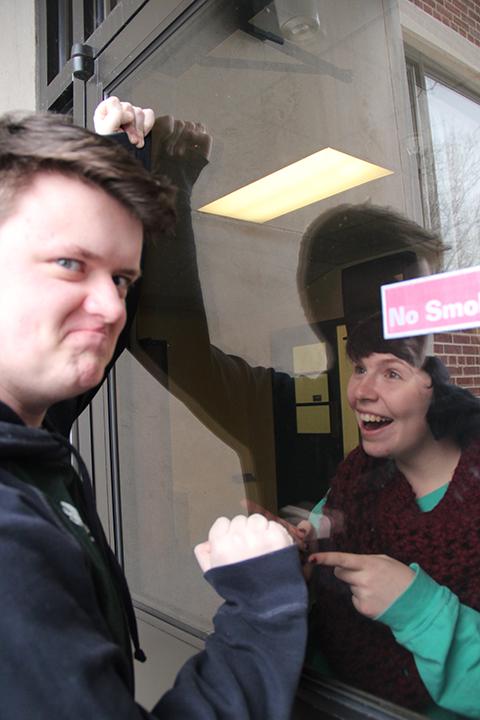He said, she said: Free education?
Brigid Edumunds and Pat Kernan argue over the merits of President Obama’s free college education plan Photo credit/ Alex Weidner
February 22, 2015
She said:
The first thing I learned in my high school Economics class is TINSTAAFL, or “There Is No Such Thing As A Free Lunch.”
This means that if you or I were to get something for free, it really isn’t free because somewhere down the line, someone else is putting the money in.
This may seem like a simple concept to grasp, but I have noticed that not many people get it.
Another thing I learned at a very young age is that if something sounds too good to be true, it probably is.
In January, Obama pitched a proposal that would allow students to attend community college free for two years so that everyone has a fair shot at higher education. To many, this seems like a “cure-all” to the problem. Now everybody will have the chance to earn a degree and to be more equipped for jobs that aren’t minimum wage based.
There are a few problems with this; free doesn’t exist, bachelor’s degrees are losing their value, the price of college needs fixing, and public schools are not preparing kids for college.
The most important thing to remember is that nothing is free. That notion does not exist. Both the Associated Press and CNN pointed out that the proposed bill will cost billions as well as increase national debt.
While it may seem like a great idea right now, those dollars will add up and Americans will be paying for it-literally. Besides, the cost of free college isn’t the only issue.
We have all heard it before: our bachelor’s degrees are becoming useless. Since so many people can now afford to go to college, we are starting to see the decreased value of a B.A. or a B.S. Students are now going to college even longer to obtain master’s degrees or to get their doctorates.
Free college will lead to more and more people earning bachelor’s degrees; as more people earn bachelor’s degrees, their value will continue to plummet.
The long term issue will be that soon everyone will need a master’s degree to stand a chance in the job market, which can be grossly expensive. According to Columbia University, to enroll in their master of arts program in journalism (a nine-month program), the estimated cost with living expenses is $85,118. That is just shy of the cost of four years of a Marywood undergraduate education.
So, what is the answer? It depends on which America wants to fix first, the cost of college or public education. CNN writer Michael B. Horn addressed one of the root problems accurately: Helping students pay for college isn’t the problem that needs fixing, it is the cost of a college education that needs to be addressed.
He said:
Brigid, I think you’re right when you say that a lot of people are thinking of President Obama’s plan as a “cure-all.” People act as though making college free for two years will fix everyone’s problems, but it won’t.
What it will do, though, is help.
According to College Board, the average price per year of a private four-year institution, like Marywood, was $31,231 in 2014, before room and board and other expenses are even considered. Multiply that by four years, and it doesn’t take a college education to realize you’ll end up with a huge sum of debt by the time you get your degree.
It should be emphasized that President Obama’s plan won’t pay for all four years of education. According to PBS, it will only pay for the first two years of education at a community college, and only for students who maintain a GPA at or above 2.5.
This addresses your main point, Brigid. The President’s plan will make it cheaper for a student to get his or her degree, but it won’t make it any easier. Although more people will conceivably be getting their degrees with the lowered cost, I don’t think that the value of the degree will be as watered down as you’re making it out to be. Ultimately, the President’s plan aims to make sure only those most likely to get the most of an education will find it easier to get one.
Hopefully, students will be pursuing degrees in growing fields in order to keep their degrees as valuable as possible. This means more STEM majors, and fewer art ones. The technological world is where new jobs are, and unfortunately artists will struggle. Ideally, most of the students who take advantage of President Obama’s plan will recognize this.
While you argue that the problem is the undervaluing of bachelor’s degree, I would argue that the real issue lies in high school. With programs like No Child Left Behind in place, it is far too easy for a student to glide through high school all the way to a diploma.
Unfortunately, as any astute reader with some knowledge of the Constitution will point out, the educational system is one of the rights afforded to the states, not the federal government, which makes any sort of sweeping reform to the entire nation’s educational system incredibly difficult. Until some sort of plan is put in place to make the high school diploma valuable again, President Obama’s proposed reform is the best we’ve got.
Contact the writer:
[email protected]





